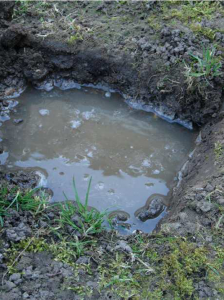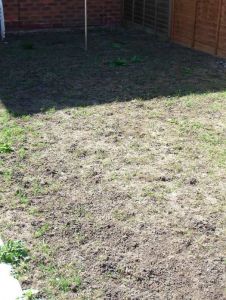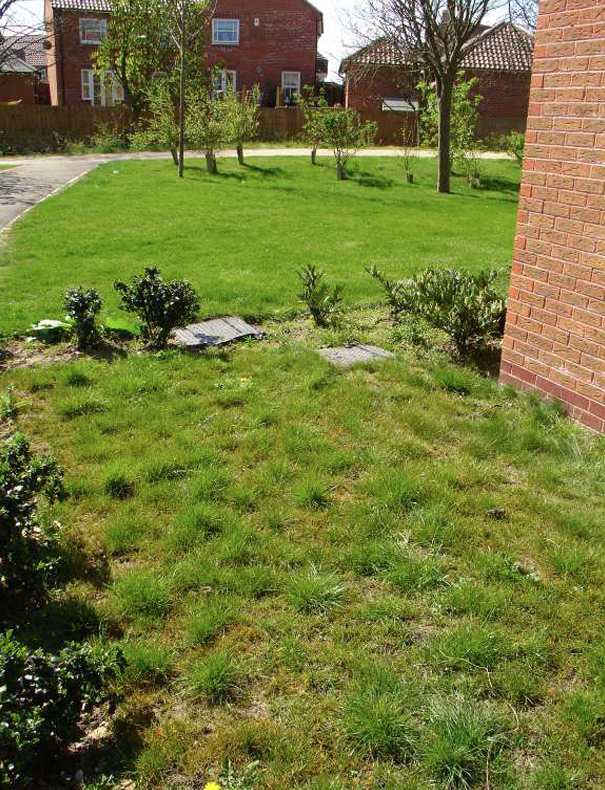Wet back gardens
1. Causation Diagnosis: there are several causes: and often the worst cases are a product of several of these causes coinciding. These are (inter alia) a) former road ways insufficiently broken out (common with old mental hospital or MOD sites); b) old haul roads; c) old materials/ build access routes into courtyards; d) heavy London Clay sites, with dense trafficked areas, not relieved sufficiently; e) slopes on clay sites with screen walls (& founds’) down slope – acting as a dam; f) Clay capping layers due to contamination; g) working in excessively inclement weather, resulting in deep compaction and clay smearing – resulting in a perched water table.h) hard pan – caused by acid soil leaching (rare and only relates to podzolised Sandy soils). I) concrete bases or foundations or crane bases left in situ; j) buried builders rubble.

2. Solution options (cost benefit analysis): As it is always best to keep it simple and short (KISS); a) positively drain the water to the surface water system (issue – cost, sewer ca
pacity and summer drought – when you need that water back: feast & famine); b) for better: create a long sump so water collects in this, but under ground (i.e. a French drain – but no pipe), but it has to be big enough – so best to form a letter ‘T’ – so the stem feeds the cross. Depth according to severity – suggest between 1 & 2 ft (300-600mm). The latter for really wet sites. Prevents over-draining – so water available when summer droughts come – and they will, due to Climate Change (more Med’ type summers – but horrid cool & wet winters). The future is going to be all about water management…
.
mp pretty! Wrap the trench with Terram or Hytex ‘convertex’ (cheaper). Leave 50mm of soil over the Covertex – wrap (all finished flush) and seed, (or plant each side of the French drain, using water-loving and attractive flowering species – helping to absorb and lose the excess water in the summer months).5. Suitable customer friendly plants that love their feet being wet include: – a) Day lilies; loads of varieties / leaves push through late Feb. These have loads of flowers all summer. Hemerocallis (in variety); b) Fox glove, digitalis: c) Bergenia (in variety); d) Alchemilla mollis; e) Rogersia piñata and aesculifolia; f) Iris leavigata & I L “Variegata”; g) Iris foetidissima; h) Gerranium (in variety); and for shrubby things – a) Cornus ‘Midwinter Fire’ ; b) Photonia ‘Red Robin’ & ‘Little Red Robin’ c) Bamboo’s (in Var) (can be invasive); Rhoderdendron (in var’- they prefer wetness over acidity – despite rumours); Hydrangea (in Var’) but H ‘Anabelle’ is spectacular – also Quercifolia, Limelight, Grandiflora.
4
. Make the su
Generally plant these each side of the sump and in a cultivation strip 500mm to 1m wide – the latter for the shrubbier species.
6. Plan C; (a go-too place if all fails thus far!).Terra venting is a process you can contract out to a specialist firm – involving a compressed air injection system, and this applied to impervious clay (if not too wet or too dry) shatters the clay and provides new ‘Structure’ I. E. All the little fissures and cracks that form in clay soils after decades of winter / summer freezing, thawing and baking. This allows new clay substrates to drain. The key is the timing.
7. Plan D: the last resort : dig out the rubble / hard pan / haul road – and replace soil / rubble with imported Sandy loam topsoil (top 200mm only), beneath – Sandy loamy subsoil: (very expensive, invasive and the absolute last resort, but frankly – this must be due to the quality of the ground works contractor’s efforts – so can you claim?
8. Get a report from me as an independent expert to demonstrate to the relevant customer’s that the issue has been taken seriously. Can be very cost effective.
9. Outside lockdown, I or a senior team member here at JBA could come down and explain about seasonal waterlogging and drought and the need to avoid over draining – sometimes helps dilute and diffuse any conflict dynamic from the customer’s side.





